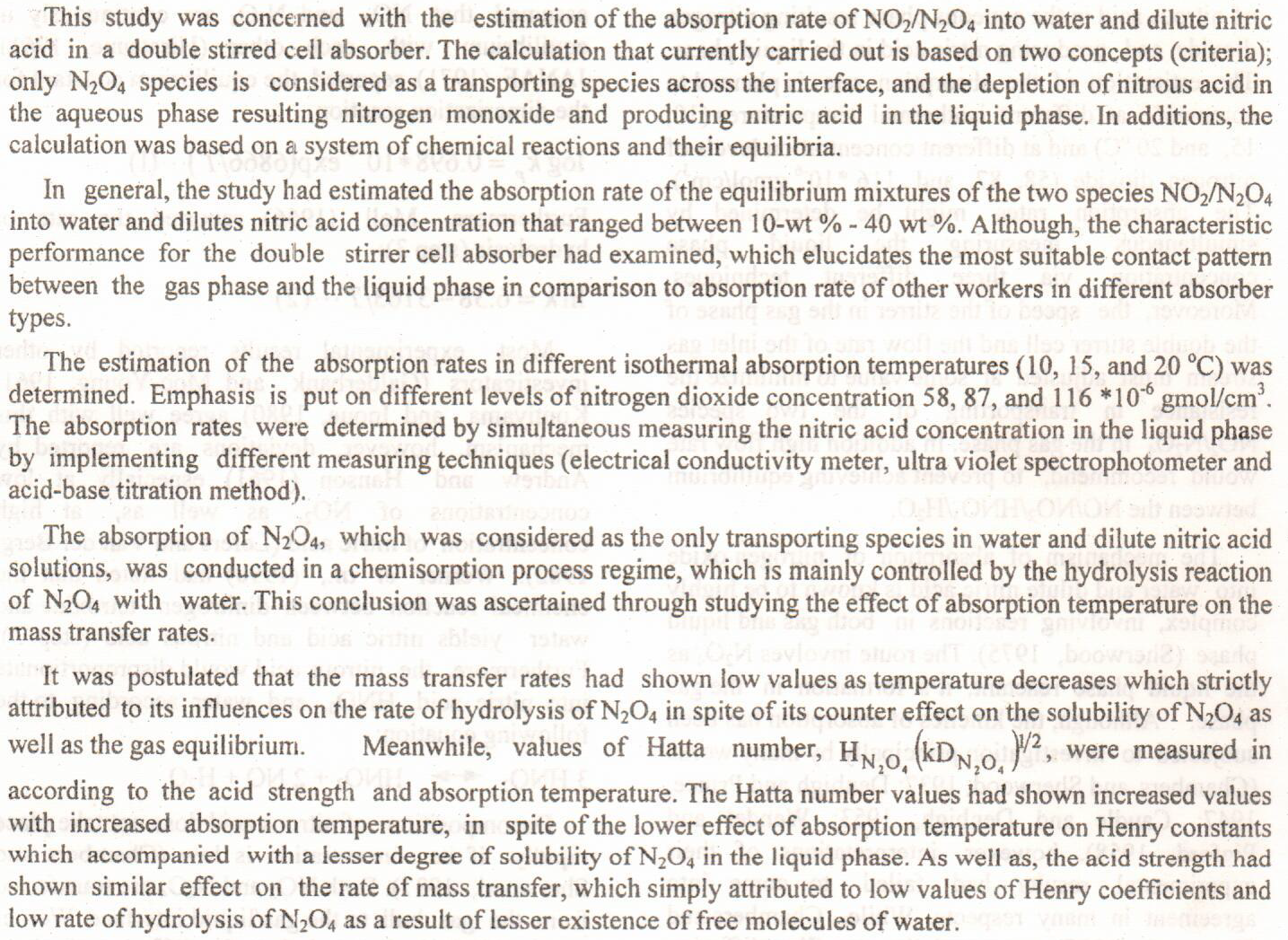
Environmentally friendly copper oxide nanoparticles (CuO NPs) were prepared with a green synthesis route via Anchusa strigosa L. Flowers extract. These nanoparticles were further characterized by FTIR, XRD and SEM techniques. Removing of Gongo red from water was applied successfully by using synthesized CuO NPs which used as an adsorbent material. It was validated that the CuO NPs eliminate Congo red by means of adsorption, and the best efficiency of adsorption was gained at pH (3). The maximum adsorption capacity of CuO NPs for Congo red was observed at (35) mg/g. The equilibrium information for adsorption have been outfitted to the Langmuir, Freundlich, Temkin and Halsey adsorption isot
... Show More (3)
(3)
 (1)
(1)
The aim of this paper was to investigate the removal efficiencies of Zn+2 ions from wastewater by adsorption (using tobacco leaves) and forward osmosis (using cellulose triacetate (CTA) membrane). Various experimental parameters were investigated in adsorption experiment such as: effect of pH (3 - 7), contact time (0 - 220) min, solute concentration (10 - 100) mg/l, and adsorbent dose (0.2 - 5)g. Whereas for forward osmosis the operating parameters studied were: draw solution concentration (10 - 150) g/l, pH of feed solution (4 - 7), feed solution concentration (10 - 100) mg/l. The result showed that the removal efficiency by using adsorption was 70% and the removal efficiency by using forward osmosis was 96.2 %.
... Show MoreIn this study, vegetable tanned leather waste of cow (VTLW-C) is used as adsorbent for removing methyl violet 10B dye from aqueous solution. The VTLW-C adsorbent was characterized by FTIR and SEM in order to evaluate its surface properties before using in adsorption experiments. Batch adsorption method was applied to study the effect of different factors such as weight of leather waste, time of shaking, and starting concentration of methyl violet 10B dye. Different isothermal models such as Langmuir, Freundlich, Temkin and Dubinin-Radushkevich (D–R) were used to analyze the experimental data. Kinetic study proceeds using (PFO) kinetic model and (PSO) kinetic model. The results showed better agreement with the Freundlich model; this means
... Show More (4)
(4)
Removal of heavy metals from waste water has received a great deal of attention. The compare Cr
(VI) adsorption characteristics removing from wastewater by using thermally modified and non-modified
eggshells were examined
 (80)
(80)
 (79)
(79)
This study was concerned with using ozone gas in drinking water treatment plant at Ibn-Sina Company. The main purpose of this research is to find the best contactor for ozone unit proposed. An investigation was conducted to study the absorption of ozone by water in two type of absorber. The effects of the process variables (such as height of water column, contact time, and pH) on the amount of ozone absorbed were investigated. Box-Wilson central composite rotatable design is used to design the experimental work for the mentioned variables. It was found that the optimum value of the variables studied was:
i) Height of water column (90 cm)
ii) Contact time (17-18 min)
iii) PH (7 - 7.5)
The effect of mixed corrosion inhibitors in cooling system was evaluated by using carbon steel specimens and weight loss analysis. The carbon steel specimens immersed in mixture of sodium phosphate (Na2 HPO4) used as corrosion inhibitor and sodium glocunate (C6 H11 NaO7) as a scale dispersant at different concentrations (20,40, 60, 80 ppm) and at different temperature (25,50,75 and 100)ºC for (1-5) days. The corrosion inhibitors efficiency was calculated by using uninhibited and inhibited water to give 98.1%. The result of these investigations indicate that the corrosion rate decreases with the increase the corrosion inhibitors concentration at 80 ppm and at 100ºC for 5 days, (i.e,
... Show MoreDora petroleum refinery waste water is the one of the important source of pollution by priority pollutant aromatic compound discharged to Tigris river in Iraq. the station has waste water treatment unit contains many treatment subunits The most important sub units is :skimmer units ,physiochemical unit ,daf unit, biological unit. The aim of research project is to study the ability of unit to remove the priority pollutant aromatic compound and follow up these compounds in river to study ability of river to self removal. A solid phase extraction (SPE) followed by high performance liquid chromatography-ultra violet (HPLC-UV) technique is depicted for the quantitative estimation of benzidines and phenols. Experimental studies were performed to
... Show MoreBackground: Denture cleansing is an important step that can prevent the spread of infection and improve a patient's health, the durability of the dentures, and the overall quality of life; therefore, it is necessary to choose a suitable cleanser that, in addition to being effective, does not have an unfavorable effect on the qualities of the denture base resin itself when used for an extended period. Aim: This research aims to assess the effects of ozonated water on the surface roughness and hardness of heat-cured acrylic resin by immersion technique. Materials: Sixty bars shapemade of heat-cured acrylicweremanufactured.Thirty samples for every test, including: (surface hardness and surface roughness). Then, these samples were divided into
... Show MoreAbstract. Froth flotation is a well-known solid-liquid separation technique. Hydrophobicity is the main driving force for such processes. Hydrophobic solids attach to air bubbles and rise up while hydrophilic or less hydrophobic species settle down. Froth can be produced with chemical frothers such as alcohols and polyglycols. However, the use of chemicals limits the use of this separation method in applications such as drinking water, food, and pharmaceutical industries. Therefore, developing a technique that produces froth without adding any chemicals would be useful to such industries. This work demonstrates that with suitable operating parameters a 27 cm froth height can be obtained in a 20 cm diameter column by using an air
... Show More